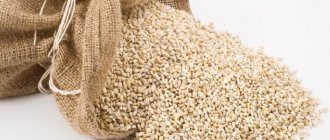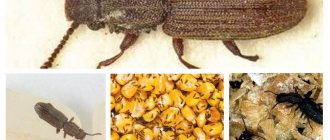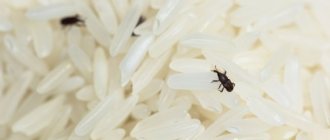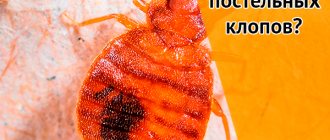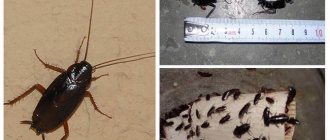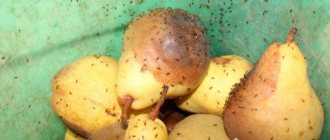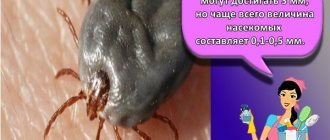Small nasty bugs in flour and cereals can be a real disaster. And such a misfortune occurs not only among slobs and lazy people; not a single decent housewife or clean person is immune from this.
You just need to know a few basic rules and a couple of little tricks in order to eat calmly and not suffer from the presence of these small, ubiquitous bugs, which, by the way, can seriously damage not only your nerves, but also your health.
What bugs are found in cereals and flour?
- Red flour beetle - the name itself suggests, it is most often found in flour:
- This is a small bug of a rusty-yellow color, with a body 1.5-2.5 mm thick, which is densely covered with villi.
- Red flour eaters live in mills, flour mills, cereal factories and bakeries and feed there mainly on waste and rotten, too wet grain. But these pests are not interested in high-quality and well-dried grain and cereals with a moisture content of up to 15%.
- They end up in such products due to violations at the enterprises themselves and uncleanliness of employees, but soon die there.
- It can settle down in your kitchen only if it finds a humid habitat with food waste. Moreover, this could be not only near cereals, but also a bag of cookies or dried fruits.
- Surinamese mucoed, aka just a mucoed, aka flour beetle:
- These are dark brown bugs, almost black, with a reddish tint. They have a hard, elastic shell that perfectly protects them from the unfavorable environment.
- One of the most arrogant and ubiquitous pests, which most often gets in with flour or starch, but then easily gnaws through polyethylene and methodically crawls into all bags of cereals. With its jaws, it is excellent at dealing not only with bags, but also with fabric bags and cardboard boxes.
- It is not afraid of low or high temperatures, and tolerates dry air and high humidity well.
- It multiplies quickly, leaving invisible larvae everywhere.
- It eats not only all kinds of cereals, without exception, but also pasta, cookies, coffee, tea and even spices.
- Bread grinder:
- It looks like a light brown bug, up to 3 mm in size.
- Lives in bakeries and bakeries. From there it gets into the apartment, along with the purchased bakery product.
- Unlike most of its “comrades” it is not afraid of sunlight, so it is not afraid and is easily detected.
- In addition to bread, they happily eat cereals, and also do not disdain tea, coffee and even medicinal dried herbs. And they are even added to dry animal feed, mixed feed and other grain mixtures.
- Food moths are flying insects that can be mistaken for ordinary house moths that hunt for your wool blanket or fur coat, but no, they hunt for food:
- The food moth is a small butterfly with silvery wings and a body about 1 cm long.
- They do not reproduce too quickly, but they do it in the most unexpected places, flying from place to place and laying eggs there.
- Larvae often settle in cracks and joints of windows and cabinets, so getting rid of them is actually difficult; you need to thoroughly clean the entire apartment, not just the kitchen.
Mucoed - general information
The insect is a representative of the family of flat beetles. The main difference of the mucoed beetle is its elongated brown body. The most common varieties of the pest are red and Suriname. The red mukoeater has a light rusty body, up to 2 mm long. Long hairs run along the shell, and multidirectional long antennae are present on the head.
The lifespan of the red mucous eater is about six months. The females of this pest lay eggs in grocery products, and after a few days the larvae hatch, turning into pupae after 90 days. The red-colored type of insect lays up to 100 eggs in 5 clutches during its life. Mucoeda larvae are pale beige in color, body length is up to 4 mm. At the end of the abdomen there are 2 hook-shaped outgrowths. The pupa is faded yellow, with spines on the lower edge of the cocoon.
For reference! The mealworm's parameters are small, but these insects are capable of spoiling a large volume of dry food supplies.
On the sides of the body of the Surinam mucoed there are teeth, which gave it its second name - the saw beetle. There are flat grooves along the back. Males are distinguished by teeth on the lower part of the body. The lifespan of this species is up to 3 years; during this period the bug is capable of producing large offspring. The Surinamese species of mucoed goes through the standard stages of development for insects:
- egg;
- larva;
- chrysalis;
- adult.
The female lays 30 eggs at one time. Of these, after 12 days, larvae appear - the body is yellowish or whitish, and the head of the insect is brownish. After 21 days, the larvae form cocoons for transformation. After pupation, after 10 days, the pests become adult mucoeds. Both the red and Surinamese varieties of mucoeds are classified as flying insects.
What does a bug eat and living conditions?
The normal temperature for the development and high activity of mucoeds is 23-25 C. Air humidity also plays a significant role. When the air temperature is negative, the insect loses its ability to reproduce and quickly dies. The pest is voracious and can damage all suitable food supplies. But the parasite prefers dry foods:
- flour;
- cereals;
- pasta;
- dried flour products (crackers, bagels, etc.).
However, the harmful insect is capable of feeding on vegetables, dry varieties of animal food, dried fruits, bread and other things. But, the mucoed eater chooses flour as its main habitat, and less often, cereals. By parasitizing food supplies, the mucoed eater secretes certain enzymes and waste products of its own vital activity. If there are bugs in supplies, bulk and other products become moldy faster than usual.
Attention! It is not recommended to eat food contaminated with mucoeds, since traces of their vital activity can potentially lead to the development of allergies.
How does it harm
Flour eaters sometimes appear at home along with the purchase of food - the bugs enter the home with bulk products, often cereals, flour, pet food, and dried fruits. Pests appear in grocery bags due to insufficient monitoring of the quality and storage conditions of products in enterprises and warehouses. But it is possible to detect a mucous beetle in an apartment not only by bringing an individual from the store - the parasites have high mobility and are able to independently enter the home. If such parasites appear, then it is necessary to get rid of the mucoat for the following reasons:
- During their life, parasites lay eggs in stored food, contaminating it with toxins, feces and chitinous cover, which they discard. The eggs and chitin of mucous beetles are toxic to people who are highly susceptible to allergens - the waste products of the bugs can provoke allergic reactions.
- Toxic compounds that end up on dry food supplies can cause digestive disorders even in people who are not prone to allergies.
- Parasites can be carriers of microbes and pathogenic fungi, which not only render supplies unusable, but also provoke various diseases in animals and people who have consumed contaminated food.
The main food of mucoeds are products whose natural moisture content ranges from 10-15%. When a product has less moisture to make it suitable for food, the pest actively contaminates it with its excrement to increase the moisture content to an acceptable value. After dry foods are “moistened,” harmful insects begin to actively eat them.
Signs and causes of appearance
Mucoeds appear in homemade cereals if their storage standards are violated - even when neighbors have these pests, they are likely to appear in hermetically sealed dry products if their humidity standards are observed, mucoeds are highly likely to not appear in them. But even if the correct storage conditions for flour, cereals and other things are observed, pests can appear in products due to unsuccessful purchases.
For reference! More often, insects are brought home in flour and cereals when purchasing these products at the market.
How does this pest enter the premises?
In the wild, the mucoed's life expectancy is short. It is often found under tree bark and in rotten stumps. If there is any food processing enterprise nearby, the flour eater quickly moves there. During the construction of barns, mills, feed mills and bakeries, the harmful insect appears there extremely quickly and, due to favorable conditions for the life of the parasite, it lives much longer. The mucoed gets into residential buildings and apartments in the following ways:
- With low-quality pet food and grain packages for rodents and other pets.
- In factory bags with contaminated cereals and flour, in the case of jars that are not closed tightly enough, it quickly spreads throughout all food supplies.
- In enterprises and within the boundaries of small settlements, parasites are able to fly away, thereby independently expanding their habitat.
But, in most cases, bugs have appeared in cereals and flour due to the fact that they were brought from the store in a bag of products or got into household supplies of dry food on clothes - in the case of someone living in the house/apartment working on any enterprise related to the food industry. Further spread throughout the kitchen occurs due to non-compliance with storage standards for dry and bulk products and late detection of harmful insects.
Ways to get rid of bugs
To get rid of bugs, it is necessary to carry out a whole range of measures to destroy not only them themselves, but also their offspring, waste products. And first of all, this is, of course, to carry out high-quality cleaning. Armed with rags and sponges, you will have to open all the kitchen cabinets and empty and treat all the shelves and drawers.
It is necessary to carefully sweep away any remaining grains that may have spilled and simply wipe everything with a dry or slightly damp cloth. After this you can proceed to processing:
- Table vinegar copes well not only with adults , but also with their larvae and eggs.
- Therefore, you need to dilute 9% vinegar approximately 1:1 with plain water and wipe all surfaces with this solution. And not only the horizontal shelves themselves, but also the vertical ones, including the doors.
- Particular attention should be paid to the joints. If your furniture allows it (not varnished), you can pour the solution into a spray bottle and spray hard-to-reach joints, for example, in the area of hinges on doors.
- Then dry the furniture thoroughly so that it does not get wet or deteriorate.
- Soda-salt solution can be used instead of vinegar. Dissolve a couple of tablespoons of ordinary rock salt and a spoonful of baking soda in a liter of warm water, stir well, the solution is ready.
Now let's move on to storage containers:
- If you choose glass or plastic containers for storage , then you need to not only wash them, but also thoroughly pour boiling water over them, which will kill the bug eggs.
- If you store cereals in fabric bags , then they should not only be washed, but also boiled.
- It’s better not to do anything with plastic bags , but simply throw them away and immediately into the garbage disposal, and not into the trash can in the kitchen, from where the parasites will quickly crawl back out.
What is an insect
The pest belongs to the darkling beetle family.
They got their name because of the dark color of their representatives. Color varies from dark brown to blue-black. Darkling beetles feed on field plant seeds and pollen.
Some species have adapted to coexist with humans. Instead of seeds, they eat flour and cereals. These types include:
- large flour beetle;
- Small mealy beetle.
Adults of both species have an elongated brown body. The intensity of the shade can vary and be lighter or darker. The cephalothorax is massive, trapezoidal in shape. The head is small, ending in two short, segmented antennae. The beetle's legs are quite short and massive. Despite this, the insect runs quickly and easily hides from danger.
Large and small Khrushchaki have different body lengths. As the name implies, the latter is slightly smaller than its brother. In addition, this beetle is slightly lighter in color.
The larva has a worm-like body, divided into several annular segments (usually 10 - 12). The color of the body is brownish-yellow. However, sometimes you can find almost white ones. The larvae have a hard head ending in a powerful jaw apparatus.
It also has 6 short legs. The larva does not have eyes. In the back of the body, near the anus, there are 2 dense warts, visible to the naked eye. They help the larva move. The insect is repelled by them from a hard surface.
When the larva reaches the required age (usually about 12 months), it pupates. A few months later, an adult emerges from the pupa, ready for reproduction. This happens in August – September. The female adult mates and lays 100 to 200 eggs. The insect's life cycle repeats.
In heated rooms, the rate of mealworm reproduction increases sharply. An insect can easily produce 3–4 generations in 1 calendar year.
How to get rid of bugs forever
You won't be able to get rid of bugs forever. Every time you return from the store with another bag of cereal or flour, with a new freshly baked loaf, you risk bringing insects into your house.
You can only prevent their occurrence as much as possible by following simple recommendations. And reduce the risk of contamination of all products in the kitchen, as well as the proliferation and prosperity of uninvited guests.
There is no 100% way to protect yourself from bringing contaminated grains into your kitchen. The risk is somewhat reduced by the fact that the goods are packaged in sealed bags; such bugs can get into them mainly at the stage of manufacturing and packaging of the goods.
Every time you return from the store with another bag of cereal or flour, with a new freshly baked loaf, you risk bringing insects into your home
Where do insects come from?
Pests can settle in bulk products for three reasons.
- Uncleanliness of the housewife. Unsanitary conditions in the kitchen are the least likely cause of “uninvited guests.” Even if you do general cleaning every day, you cannot be guaranteed to protect yourself from pests: insects can be brought into the house along with purchases from the store.
- Dishonesty of suppliers. Factories do not always comply with sanitary control requirements: storage conditions are often violated, and products do not undergo the necessary heat treatment. As a result, the housewife buys cereals that already contain pests.
- "Dangerous neighborhood." Insects can “immigrate” into cereals from nearby stocks of tea, herbs, pasta, dried fruits, and seasonings purchased by weight.
Reasons for the appearance of bugs in cereals and flour
Bugs themselves do not appear out of nowhere, and they almost never enter a person’s home:
- The most common reason for their appearance is that you brought them yourself, with some of the products. Alas, despite all the norms and state standards for production and sales, it is quite simple to buy a product infested with insects.
- Bugs can end up in the cereal already at the production stage , say, at the factory where it was produced, supposedly neutralized from parasites, dried, threshed and packaged.
- They may get into the bag during transportation or in one of the storage warehouses.
- Often these midges live in stores and supermarkets , where they instantly master each new batch of goods.
- Or they settle in bakeries or bakeries and from there migrate to your kitchen in a loaf of bread or a bunch of dry goods.
- Bugs can also enter along with food from neighbors who shared a glass of flour, friends or relatives who sprinkled you with some nuts or dried fruits.
- Since these insects are quite tenacious and unpretentious, they can penetrate into the cracks and joints of furniture. Therefore, one of the ways to add such an inhabitant to yourself is to purchase used kitchen furniture or interior detail, from which they will very quickly crawl out and get comfortable in a new place, closer to your food.
Why did uninvited guests appear?
Where do insects in the form of flour bugs come from?
Their celebration of life does not begin on its own, and 3 reasons contribute to this:
Contaminated product
You should not think that any “evil spirits” will not appear in a product from a trusted store. It can enter the buyer’s home after contamination of cereals during production, during transportation and directly at retail outlets.
"Gift" from neighbors
Bugs often end up in another habitat in this way. It is enough for them to find themselves in a glass of emergency help when, if it is impossible to visit the store, you ask your neighbors for something. On one landing, people are not averse to sharing flour and other products if they are on good terms. After all, next time they will not be denied their request either.
Tricky used furniture
After purchasing this part of the interior, you should then wait for a problem to appear; a bug may be hiding there. Not in all cases the outcome of events will look like this, but it won’t hurt to prepare for it. In a new place, insects quickly settle down, which is not something to doubt. In this case, it is easy to drive them away by using special methods.
Prevention of bugs
In order not to fight pests, it is better to protect yourself from their appearance and reproduction in advance. General advice is to keep it clean and ensure that cabinets are periodically ventilated.
If your furniture is quite airtight and the air in it does not circulate well, do regular ventilation by simply opening the cabinets for a short time:
- Try not to make large reserves. This, of course, will not protect you from pests, but it will significantly save your money; if a bug does settle in, you will have to get rid of the food.
- Give preference to sealed glass or plastic containers with tight lids. Only such banks will not be defeated by Khrushchev.
- If you can’t deny yourself this and still stock up on food in bags, then use dust. Herbal dust can be bought at the market, less often in a store, in the insect control department. This product must be sprinkled on the floor, under the bags. Bugs are not suitable for it, and it is absolutely safe for human health.
- Try to differentiate products rather than storing everything together on one shelf. For example, try to keep wet dried fruits away from cereals.
- Use a folk remedy for prevention – garlic. You can put a clove of garlic at the bottom of a jar of cereal. And between the jars, place dried bay leaves, which parasites cannot tolerate.
- If you still store cereals in fabric bags, then “salt” such containers. To do this, you need to prepare a saline solution, about a couple of tablespoons per 1 liter of water, and soak the bags in it. After half an hour, take them out and dry them. Parasites try to avoid such salted bags.
If you still store cereals in fabric bags, then “salt” such containers
Prevention in the presence of bulk products
Bugs bite through polyethylene, where utensils made of plastic or glass will not give them any fun. The means of prevention do not end there, and no less radical methods are used:
Stop hoarding
Semolina always amazes with the intensity of the reproduction of unnecessary living elements in it. The bugs in the apartment seem to be waiting for a “you’re welcome” signal if they want to clog the kitchen cabinets for future use for a long time.
Can't get rid of hoarding syndrome?
Buy a plant-based dust.
Insects do not like it, but such a remedy cannot harm people.
Selecting the right packaging
Khrushchev is not able to bite through glass and plastic, and will not lay claim to property made from this material. The packaging should initially be doused with boiling water so that the pest eggs are not given the slightest chance of survival. Fabric storage bags are also not prohibited, but it is recommended to boil them before use.
Extra Precaution
Some thrifty housewives keep bags in which flour and cereals were once packaged. A remedy for aggressive flour bugs in the kitchen will never help if such “wealth” is carefully stored in cabinets. You won't be able to get rid of unnecessary infestations by throwing bags in the trash. In this case, the aggressors will still return to their previous positions.
Product separation
How to remove insects without further consequences?
Everything is elementary when you lose the desire to mix the same dried fruits with cereals. It is not recommended to double the risk of insect penetration and reproduction for no apparent reason.
Freezer to the rescue
A little effort in preserving food can be costly. It is not forbidden to package the purchased product in secure containers.
Who will guarantee that products from a reputable market do not contain larvae?
Insects do not like extreme cold, so such an effect on them will not hurt.
Burning cereal
There is no need to heat it to a specific red color. In this case, we are not talking about the idealization of cereals with a questionable improvement in its qualities. Doubtful products should be subjected to heat treatment for half an hour, provided the oven is set to 200 degrees Celsius or higher.
Making your own product
It is customary to place lavender in the wardrobe area where fur and woolen products are stored. Why not fight the voiced pseudo-reformers with the help of the same lavender leaves. Heritage Nutmeg is also effective in this regard. It is enough to cut it into neat strips and place it throughout all kitchen cabinets. It is recommended to pay special attention to their joints.
Initial product review
In this case, it will not be possible to count the larvae, because such a loose contingent is insidious in all respects. Only a bread grinder has the audacity to show himself before the eyes of humanity. It is this parameter that should be studied first, so as not to grieve over the missing product later.
Potato method
For some reason, the Internet is deaf with such information. Parasites of any variety love potatoes with all their hearts. One Colorado potato beetle will show its commitment to potatoes with all its paws. There is no need to worry when growing this crop on the balcony. In this case, it is better to build next to it a neighborhood with beans, which the voiced evil spirits of insects greatly respect.
What is the benefit of such actions?
In the future, parasites will be less interested in flour.
Is it possible to eat grains and flour infested with beetles?
You cannot eat contaminated cereals and flour together with bugs. But after processing the products, it is possible, although, most likely, it will simply be unpleasant for you. Here you need to understand that even if you sort or sift the cereal, you still cannot get rid of larvae, waste products, excrement and insect scales.
All these particles in small doses are not dangerous for a healthy person. But for a child or simply a weakened body, weak immunity can have consequences in the form of intoxication. This can result in stomach upset, vomiting and fever.
If there are no health problems, then you can remove the psychological aspect and eat it after certain processing. We are talking about freezing or heating.
Almost all bugs and their offspring die when frozen to -15 degrees or heated to more than +50:
- To freeze, you need to place a bag of cereal in the freezer for a day, or if the process occurs in winter , then take the food outside or onto the balcony, just keep in mind that the temperature should not be more than -15 degrees.
- Pour the cereal onto a baking sheet, spread evenly over the entire surface and place in the oven for half an hour at a temperature of 180-200 degrees.
- After freezing or warming up, flour can be sifted through a fine sieve. By the way, the sieve holds not only the bodies of the bugs, but also their larvae, and even eggs. Therefore, flour, after all the manipulations carried out, can be safely consumed.
What's the harm?
The beetle spends the entire year of its life in the form of a larva in flour, grain or cereals, which are its main source of nutrition. He defecates there. In addition, as the larva grows, it molts, shedding its old chitinous coverings. They also remain in the products. Chitin can cause severe allergies.
Flour beetle larvae can also feed on protein foods. They often eat the corpses or excrement of mice, bird droppings and feathers. After eating this, the insect may crawl back into the flour. Birds and rodents often act as carriers of infection, so feeding on their waste products can lead to the entry of pathogenic microorganisms into food and subsequent infection of humans.
Tips and tricks
- The main advice is, of course, cleanliness combined with a few little tricks.
- When buying cereal or flour, do not rush to immediately pour it into a jar and put it in the cupboard. It is better to put the bag in the freezer overnight, or even for a day. If the cereal is infected, then this, of course, will not get rid of the bugs. But at low temperatures they will die, like their larvae and eggs, which means they will not reproduce and move to your other reserves.
- Make it a rule when cleaning cabinets to wipe them with a vinegar or water-salt solution. Dilute 9% vinegar with water 1:1 or add a spoonful of regular baking soda and salt to 1 liter of water.
- Nutmeg is a very aromatic remedy. Grind the nut as much as possible on a grater or in a mortar and, to prevent it from scattering all over the surface, take a wide piece of tape and evenly spread the resulting nut powder in a thin layer onto its strips. Then shake off the excess from the strips and cut into the amount you need. Place these nutmeg strips of scotch tape in the boxes. An effective and pleasant means of preventing bugs. You can also sprinkle already ground nutmeg from bags onto the tape.
- Lavender is another fragrant and simple remedy. Simply place the dried herbs on the shelves.
How to fight
As soon as parasites are found in supplies, you need to get rid of them immediately. Otherwise, adult beetles may lay eggs in other foods. This is not necessarily flour or grain. Pests enjoy eating dried meat, mushrooms, and dried fruits. They also eat wool, seeds and textiles.
Before you begin pest control, you must carefully inspect all supplies for the presence of insects. You need to work only with those where the parasite is found.
Ways to fight
There are various ways to get rid of pests, each homeowner can choose the appropriate one. You need to do a number of things first. Go through all bulk products and identify the source of contamination and affected packages. All provisions need to be checked, even if this type of food is not typical for beetles. If there are bugs in the cereal, then we get rid of it immediately, if there are bugs in the flour, then get rid of the flour, etc. Everything should be thrown into the trash immediately.
You should carry out general cleaning without missing a single detail. They wash all food containers, cabinets, furniture, household appliances, radiators, floors and window sills. It should be remembered that a colony can be anywhere.
On a note!
To wash containers, use soda; for the rest, dilute vinegar and use standard cleaning products.
It is better to block access to all joints and gaps in the apartment. Bulk products are poured into sealed containers and not used for 2 weeks. During this time, it will become clear whether the food is affected or not.
Where do pests most often occur?
If the kitchen is already infected and there are these insects in flour or cereal, you need to detect foci of infection. You will need to review each of the products.
Bulk products
The following subtleties need to be taken into account:
- It is important that you will need to examine any product, without exception, that is stored in the kitchen. Each type of such bugs has certain gastronomic tastes. But if his favorite food is not available in sufficient quantities, the bug can emigrate from other grains to cereals, as well as sugar, sweets, and nuts. For this reason, you should not skip a single product, so as not to waste a lot of time.
- These parasites become strongly attached to their places of residence, so they do not go far from them. If you see them on the shelf, you must first inspect the products stored nearby.
- Even if the package is hermetically sealed, it will need to be inspected. These insects easily chew through materials such as cardboard, cellophane and foil. For this reason, without opening the cereal, you should not think that it does not contain parasites.
- The best option is to pour the cereal into a plate and watch carefully. These bugs also live hidden - for example, the grinder can gnaw holes in grains and live in them, crawling to the surface only to change the grain. Therefore, a superficial inspection is ineffective.
What store-bought insect repellents are there?
We have already written what works best and what exactly can be used to get rid of bugs. But, in addition to such means, there are also all sorts of traps, for example, pheromones. You can buy a couple and place them for prevention purposes and to attract those individuals that have survived the main treatment.
Using only traps is unwise and expensive. They do not act as quickly as we would like, judging by the reviews on the Internet. And as long as there are bugs in the kitchen, the cereal will become unusable.
Preventive measures
To prevent bugs from getting into cereals, flour, pasta and bread products, you need to think about preventing food contamination and follow simple recommendations:
- Heat the purchased cereals for 30-40 minutes in the oven, after opening the package and pouring rice, buckwheat or bulgur onto a baking sheet or frying pan.
- Cereals that cannot be heated at high temperatures, such as semolina, should be frozen in the freezer compartment of the refrigerator for at least a day. Before loading into the freezer, make several small holes in a sealed bag for air circulation.
- Store dried fruits in the refrigerator.
- Before purchasing, carefully inspect packages of cereals for the presence of insects and their waste.
- Keep supplies in glass, tin or polymer containers with tight-fitting lids. Use fabric bags made of linen or cotton as soft containers.
- Inspect inventory periodically. Dispose of expired products.
And most importantly, you don’t need to buy bulk products, food concentrates, tea and coffee for future use. In the absence of a shortage, food products can always be purchased at the nearest store, thereby reducing the risk of bugs and making your life easier.
Are bugs in the kitchen dangerous?
It is difficult to unequivocally assess the harm from the presence of bugs in the kitchen for human health: if you do not eat them directly, they do not seem to be able to do much harm.
Eating such foods is not only unpleasant, but also dangerous.
However, the main danger of parasites is that they leave excrement, shells of larvae, cobwebs and particles of their scales. Such a food supplement will not bring any benefit, and in some cases it can provoke serious anaphylactic shock. Therefore, we still do not recommend there are products that are infested with bugs.
On the other hand, the taste also leaves much to be desired: bugs give all products an unpleasant musty taste, as they eat away their core, leaving only the shell.
How do they get into the house?
You buy bugs. They don't start on their own and don't fly off the street. Typically, insects come with loose cereals, which are cheaper than packaged ones.
But they can also be in sealed packaging. Therefore, watch what you take. Although, to be fair, usually “sold” are larvae that cannot be seen.
